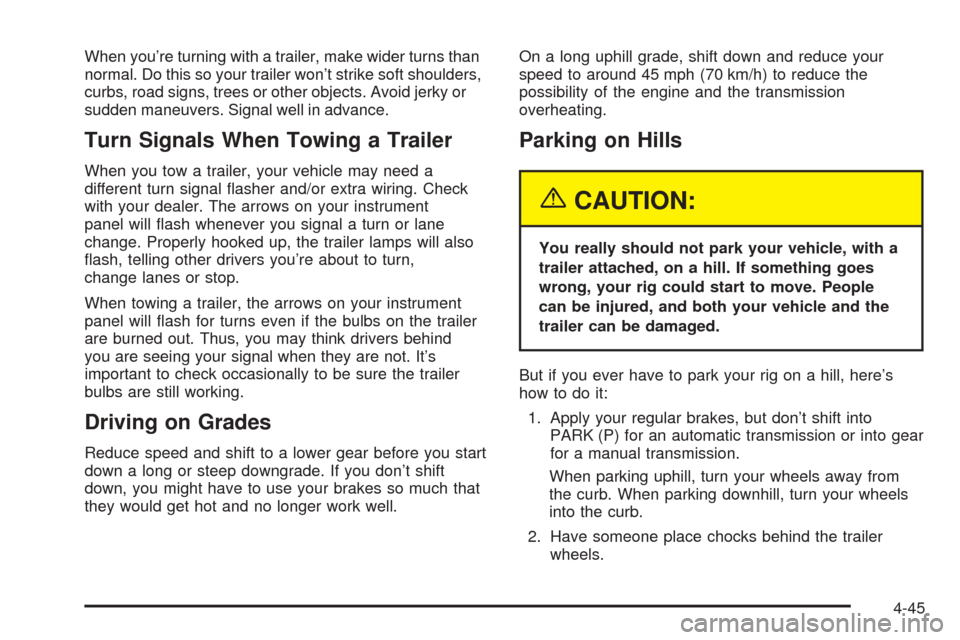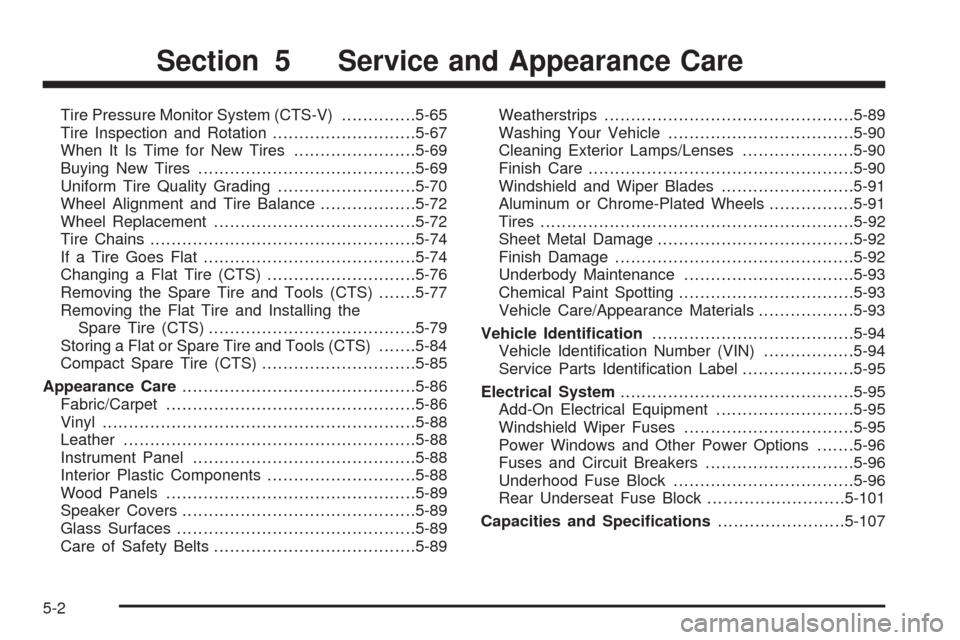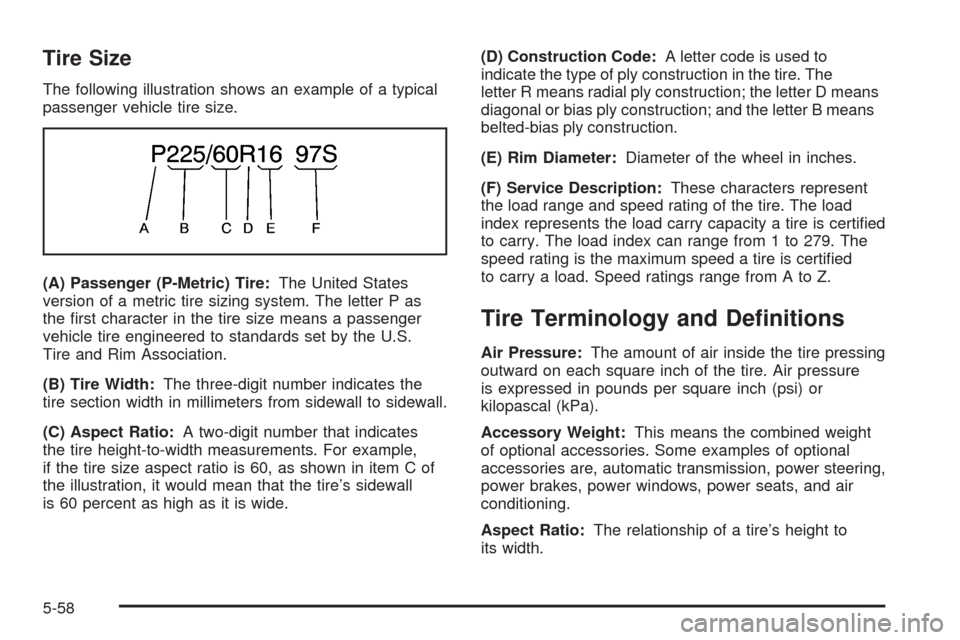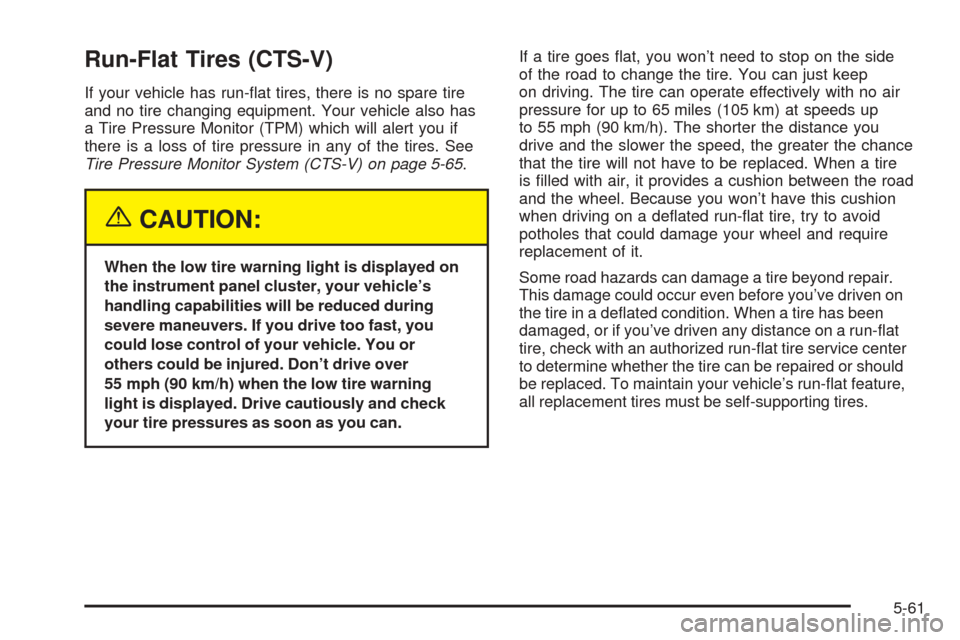wheel CADILLAC CTS 2005 1.G Workshop Manual
[x] Cancel search | Manufacturer: CADILLAC, Model Year: 2005, Model line: CTS, Model: CADILLAC CTS 2005 1.GPages: 432, PDF Size: 2.52 MB
Page 279 of 432

When you’re turning with a trailer, make wider turns than
normal. Do this so your trailer won’t strike soft shoulders,
curbs, road signs, trees or other objects. Avoid jerky or
sudden maneuvers. Signal well in advance.
Turn Signals When Towing a Trailer
When you tow a trailer, your vehicle may need a
different turn signal �asher and/or extra wiring. Check
with your dealer. The arrows on your instrument
panel will �ash whenever you signal a turn or lane
change. Properly hooked up, the trailer lamps will also
�ash, telling other drivers you’re about to turn,
change lanes or stop.
When towing a trailer, the arrows on your instrument
panel will �ash for turns even if the bulbs on the trailer
are burned out. Thus, you may think drivers behind
you are seeing your signal when they are not. It’s
important to check occasionally to be sure the trailer
bulbs are still working.
Driving on Grades
Reduce speed and shift to a lower gear before you start
down a long or steep downgrade. If you don’t shift
down, you might have to use your brakes so much that
they would get hot and no longer work well.On a long uphill grade, shift down and reduce your
speed to around 45 mph (70 km/h) to reduce the
possibility of the engine and the transmission
overheating.
Parking on Hills
{CAUTION:
You really should not park your vehicle, with a
trailer attached, on a hill. If something goes
wrong, your rig could start to move. People
can be injured, and both your vehicle and the
trailer can be damaged.
But if you ever have to park your rig on a hill, here’s
how to do it:
1. Apply your regular brakes, but don’t shift into
PARK (P) for an automatic transmission or into gear
for a manual transmission.
When parking uphill, turn your wheels away from
the curb. When parking downhill, turn your wheels
into the curb.
2. Have someone place chocks behind the trailer
wheels.
4-45
Page 282 of 432

Tire Pressure Monitor System (CTS-V)..............5-65
Tire Inspection and Rotation...........................5-67
When It Is Time for New Tires.......................5-69
Buying New Tires.........................................5-69
Uniform Tire Quality Grading..........................5-70
Wheel Alignment and Tire Balance..................5-72
Wheel Replacement......................................5-72
Tire Chains..................................................5-74
If a Tire Goes Flat........................................5-74
Changing a Flat Tire (CTS)............................5-76
Removing the Spare Tire and Tools (CTS).......5-77
Removing the Flat Tire and Installing the
Spare Tire (CTS).......................................5-79
Storing a Flat or Spare Tire and Tools (CTS).......5-84
Compact Spare Tire (CTS).............................5-85
Appearance Care............................................5-86
Fabric/Carpet...............................................5-86
Vinyl...........................................................5-88
Leather.......................................................5-88
Instrument Panel..........................................5-88
Interior Plastic Components............................5-88
Wood Panels...............................................5-89
Speaker Covers............................................5-89
Glass Surfaces.............................................5-89
Care of Safety Belts......................................5-89Weatherstrips...............................................5-89
Washing Your Vehicle...................................5-90
Cleaning Exterior Lamps/Lenses.....................5-90
Finish Care..................................................5-90
Windshield and Wiper Blades.........................5-91
Aluminum or Chrome-Plated Wheels................5-91
Tires...........................................................5-92
Sheet Metal Damage.....................................5-92
Finish Damage.............................................5-92
Underbody Maintenance................................5-93
Chemical Paint Spotting.................................5-93
Vehicle Care/Appearance Materials..................5-93
Vehicle Identi�cation......................................5-94
Vehicle Identi�cation Number (VIN).................5-94
Service Parts Identi�cation Label.....................5-95
Electrical System............................................5-95
Add-On Electrical Equipment..........................5-95
Windshield Wiper Fuses................................5-95
Power Windows and Other Power Options.......5-96
Fuses and Circuit Breakers............................5-96
Underhood Fuse Block..................................5-96
Rear Underseat Fuse Block..........................5-101
Capacities and Speci�cations........................5-107
Section 5 Service and Appearance Care
5-2
Page 320 of 432

Brake Wear
Your vehicle has four-wheel disc brakes.
Disc brake pads have built-in wear indicators that make
a high-pitched warning sound when the brake pads
are worn and new pads are needed. The sound
may come and go or be heard all the time your vehicle
is moving, except when you are pushing on the
brake pedal �rmly.
{CAUTION:
The brake wear warning sound means that
soon your brakes will not work well. That
could lead to an accident. When you hear the
brake wear warning sound, have your vehicle
serviced.
Notice:Continuing to drive with worn-out brake
pads could result in costly brake repair.Some driving conditions or climates may cause a brake
squeal when the brakes are �rst applied or lightly
applied. This does not mean something is wrong with
your brakes.
Properly torqued wheel nuts are necessary to help
prevent brake pulsation. When tires are rotated, inspect
brake pads for wear and evenly tighten wheel nuts in
the proper sequence to GM torque speci�cations.
Brake linings should always be replaced as complete
axle sets.
Brake Pedal Travel
See your dealer if the brake pedal does not return
to normal height, or if there is a rapid increase in pedal
travel. This could be a sign of brake trouble.
Brake Adjustment
Every time you apply the brakes, with or without the
vehicle moving, your brakes adjust for wear.
5-40
Page 335 of 432

Notice:If your vehicle has P245/45R18 size
tires, they are classi�ed as low-pro�le tires.
Low-pro�le tires are more susceptible to damage
from road hazards or curb impact than standard
pro�le tires. Tire and or wheel assembly damage
can occur when coming into contact with road
hazards like, potholes or sharp edged objects or
when sliding into a curb. Your GM warranty does not
cover this type of damage. Keep tires set to the
correct in�ation pressure and when possible avoid
contact with curbs, potholes and other road
hazards.
Winter Tires
If you expect to drive on snow or ice covered roads
often, you may want to get winter tires for your vehicle.
All season tires provide good overall performance on
most surfaces but they may not offer the traction
you would like or the same level of performance as
winter tires on snow or ice covered roads.See your dealer for details regarding winter tire
availability and proper tire selection. Also, see
Buying New Tires on page 5-69.
If you choose to use snow tires:
Use tires of the same brand and tread type
on all four wheel positions.
Use only radial ply tires of the same size,
load range, and speed rating as the original
equipment tires.
Winter tires with the same speed rating as your original
equipment tires may not be available for H, V, W
and ZR speed rated tires. If you choose snow tires with
a lower speed rating, never exceed the tire’s maximum
speed capability.
5-55
Page 338 of 432

Tire Size
The following illustration shows an example of a typical
passenger vehicle tire size.
(A) Passenger (P-Metric) Tire:The United States
version of a metric tire sizing system. The letter P as
the �rst character in the tire size means a passenger
vehicle tire engineered to standards set by the U.S.
Tire and Rim Association.
(B) Tire Width:The three-digit number indicates the
tire section width in millimeters from sidewall to sidewall.
(C) Aspect Ratio:A two-digit number that indicates
the tire height-to-width measurements. For example,
if the tire size aspect ratio is 60, as shown in item C of
the illustration, it would mean that the tire’s sidewall
is 60 percent as high as it is wide.(D) Construction Code:A letter code is used to
indicate the type of ply construction in the tire. The
letter R means radial ply construction; the letter D means
diagonal or bias ply construction; and the letter B means
belted-bias ply construction.
(E) Rim Diameter:Diameter of the wheel in inches.
(F) Service Description:These characters represent
the load range and speed rating of the tire. The load
index represents the load carry capacity a tire is certi�ed
to carry. The load index can range from 1 to 279. The
speed rating is the maximum speed a tire is certi�ed
to carry a load. Speed ratings range from A to Z.
Tire Terminology and De�nitions
Air Pressure:The amount of air inside the tire pressing
outward on each square inch of the tire. Air pressure
is expressed in pounds per square inch (psi) or
kilopascal (kPa).
Accessory Weight:This means the combined weight
of optional accessories. Some examples of optional
accessories are, automatic transmission, power steering,
power brakes, power windows, power seats, and air
conditioning.
Aspect Ratio:The relationship of a tire’s height to
its width.
5-58
Page 341 of 432

Run-Flat Tires (CTS-V)
If your vehicle has run-�at tires, there is no spare tire
and no tire changing equipment. Your vehicle also has
a Tire Pressure Monitor (TPM) which will alert you if
there is a loss of tire pressure in any of the tires. See
Tire Pressure Monitor System (CTS-V) on page 5-65.
{CAUTION:
When the low tire warning light is displayed on
the instrument panel cluster, your vehicle’s
handling capabilities will be reduced during
severe maneuvers. If you drive too fast, you
could lose control of your vehicle. You or
others could be injured. Don’t drive over
55 mph (90 km/h) when the low tire warning
light is displayed. Drive cautiously and check
your tire pressures as soon as you can.If a tire goes �at, you won’t need to stop on the side
of the road to change the tire. You can just keep
on driving. The tire can operate effectively with no air
pressure for up to 65 miles (105 km) at speeds up
to 55 mph (90 km/h). The shorter the distance you
drive and the slower the speed, the greater the chance
that the tire will not have to be replaced. When a tire
is �lled with air, it provides a cushion between the road
and the wheel. Because you won’t have this cushion
when driving on a de�ated run-�at tire, try to avoid
potholes that could damage your wheel and require
replacement of it.
Some road hazards can damage a tire beyond repair.
This damage could occur even before you’ve driven on
the tire in a de�ated condition. When a tire has been
damaged, or if you’ve driven any distance on a run-�at
tire, check with an authorized run-�at tire service center
to determine whether the tire can be repaired or should
be replaced. To maintain your vehicle’s run-�at feature,
all replacement tires must be self-supporting tires.
5-61
Page 342 of 432

As soon as possible, contact the nearest authorized GM
or run-�at servicing facility for inspection and repair or
replacement. To locate the nearest GM or run-�at
servicing facility, call Roadside Service. SeeRoadside
Service on page 7-5for details.
{CAUTION:
Run-�at tires are constructed differently than
other tires and could explode during improper
service. You or others could be injured or killed
if you attempt to repair, replace, dismount, or
mount a run-�at tire. Let only an authorized
run-�at service center repair, replace, dismount
and mount run-�at tires.
The valve stems on your run-�at tires have sensors that
are part of the Tire Pressure Monitor System (TPMS).
These sensors contain batteries which are designed
to last for 10 years under normal driving conditions. See
your dealer if you ever need to have a wheel replaced,
or if the sensors ever need replacement.Notice:Using liquid sealants can damage the
tire valves and tire pressure monitor sensors in your
run-�at tires. This damage would not be covered
by warranty. Don’t use liquid sealants in your
run-�at tires.
In�ation - Tire Pressure
Tires need the correct amount of air pressure to operate
effectively.
Notice:Do not let anyone tell you that
under-in�ation or over-in�ation is all right. It is not.
If your tires do not have enough air (under-in�ation),
you can get the following:
Too much �exing
Too much heat
Tire overloading
Premature or irregular wear
Poor handling
Reduced fuel economy
5-62
Page 345 of 432

Tire Pressure Monitor System
(CTS-V)
The Tire Pressure Monitor (TPM) System uses radio
and sensor technology to check tire pressure levels.
If your vehicle has this feature, sensors are mounted
on each run-�at tire and wheel assembly. The TPM
sensors transmit tire pressure readings to a receiver
located in the vehicle once every 60 seconds while the
vehicle is being driven, and once every 60 minutes
if the vehicle is stationary for more than 15 minutes.
Using the Message Center, tire pressure levels can be
viewed by the driver. For additional information about
the message center operation and displays, see
Message Center (CTS-V) on page 3-51.
When a low tire pressure condition is detected, a low
tire warning light, on the instrument panel cluster,
comes on to warn the driver.
When the tire pressure
monitoring system warning
light is lit, one or more
of your tires is signi�cantly
under-in�ated.You should stop and check your tires as soon as
possible, and in�ate them to the proper pressure as
indicated on the vehicle’s tire information placard.
Driving on a signi�cantly under-in�ated tire causes
the tire to overheat and can lead to tire failure.
Under-in�ation also reduces fuel efficiency and tire tread
life, and may affect the vehicle’s handling and stopping
ability. Each tire, should be checked monthly when
cold and set to the recommended in�ation pressure as
speci�ed in the vehicle placard and owner’s manual.
The Tire and Loading Information label (tire information
placard) is attached, to either, the center pillar near
the driver’s door latch post or on the rear edge of the
driver’s side rear passenger door. The label shows
the size of your vehicle’s original tires and the correct
in�ation pressure for your vehicle’s tires when they
are cold. SeeIn�ation - Tire Pressure on page 5-62and
Loading Your Vehicle on page 4-33for additional
information.
Your vehicle’s TPM system can alert you about a low
tire pressure condition but it does not replace normal
tire maintenance. SeeTire Inspection and Rotation
on page 5-67andTires on page 5-54.
Notice:Do not use a tire sealant if your vehicle is
equipped with Tire Pressure Monitors. The liquid
sealant can damage the tire pressure monitor
sensors.
5-65
Page 346 of 432

TPM Sensor Identi�cation Codes
Each TPM sensor has a unique identi�cation code. Any
time you replace one or more of the TPM sensors, the
identi�cation codes will need to be matched to the new
tire/wheel position. Each tire/wheel position is matched,
to a sensor, by increasing or decreasing the tire’s air
pressure. The sensors are matched, to the tire/wheel
positions, in the following order: left front (LF), right
front (RF), right rear (RR), and left rear (LR).
You will have one minute to match the �rst tire/wheel
position, and �ve minutes overall, to match all four
tire/wheel positions. If it takes longer than one minute,
to match the �rst tire and wheel, or more than
�ve minutes to match all four tire and wheel positions
the matching process stops and you will need to
start over.
The TPM matching process is outlined below:
1. Set the Parking brake.
2. Turn the ignition switch to ON with the engine off.
3. Using the Remote Keyless Entry (RKE) transmitter,
lock and unlock the vehicle’s doors.
4. Press the lock and unlock buttons, at the same
time, on the RKE transmitter. A single horn chirp
will sound, indicating that the TPM system is ready,
and the sensor matching process can begin.
5. Start with the left (driver’s side) front tire.6. Remove the valve cap from the valve stem.
Activate the TPM sensor by increasing or
decreasing the tire’s air pressure for �ve seconds,
or until a horn chirp sounds. The horn chirp,
which may take up to 30 seconds, con�rms that the
sensor identi�cation code has been matched to
this tire position. To decrease the tire’s air-pressure
use the pointy end of the valve cap, a pencil-style
air pressure gage or a key.
7. Proceed to the right (passenger’s side) front tire,
and repeat the procedure in Step 6.
8. Proceed to the right (passenger’s side) rear tire,
and repeat the procedure in Step 6.
9. Proceed to the left (driver’s side) rear tire, and
repeat the procedure in Step 6.
10. After hearing the con�rming double horn chirp, for
the left rear tire, exit the matching process by
turning the ignition switch to OFF.
11. Set all four tires to the recommended air pressure
level as indicated on the tire and loading information
label.
12. Put the valve caps back on the valve stems.
The TPM system will not function properly if one or
more of the TPM sensors are missing or inoperable.
If the system detects a missing or inoperable sensor
an error message of several dashes–––will be
shown on the message center display.
5-66
Page 347 of 432

If you have replaced a tire/wheel assembly without
transferring the TPM sensors, the error message will be
displayed. Once you re-install the TPM sensors, the
error message should go off. See your GM dealer
for service if all TPM sensors are installed and the error
message comes on and stays on.
The TPM system operates on a radio frequency subject
to Federal Communications Commission (FCC) Rules
and with Industry and Science Canada.
This device complies with Part 15 of the FCC Rules.
Operation is subject to the following two conditions:
1. this device may not cause interference, and
2. this device must accept any interference received,
including interference that may cause undesired
operation.
This device complies with RSS-210 of Industry Canada.
Operation is subject to the following two conditions:
1. this device may not cause interference, and
2. this device must accept any interference received,
including interference that may cause undesired
operation of the device.
Changes or modi�cations to this system by other than
an authorized service facility could void authorization to
use this equipment.Tire Inspection and Rotation
Tires should be rotated every 5,000 to 8,000 miles
(8 000 to 13 000 km).
Any time you notice unusual wear, rotate your tires as
soon as possible and check wheel alignment. Also
check for damaged tires or wheels. SeeWhen It Is Time
for New Tires on page 5-69andWheel Replacement
on page 5-72for more information.
The purpose of regular rotation is to achieve more
uniform wear for all tires on the vehicle. The �rst rotation
is the most important. SeeScheduled Maintenance
on page 6-4.
When rotating your tires, always use the correct rotation
pattern shown here.
5-67